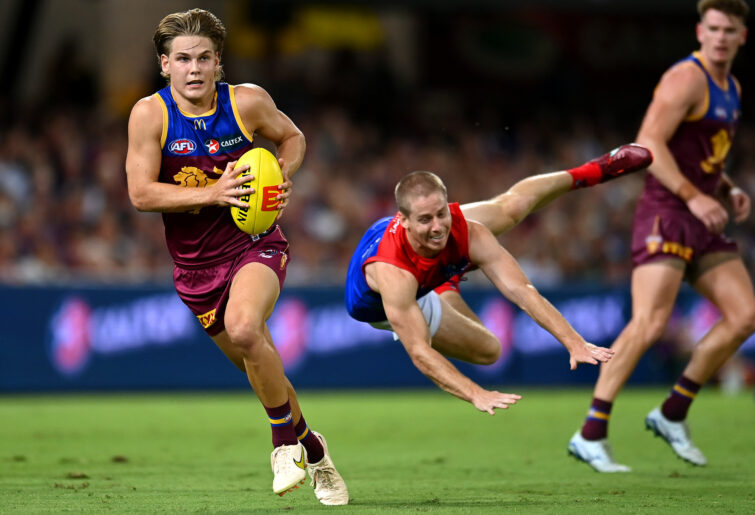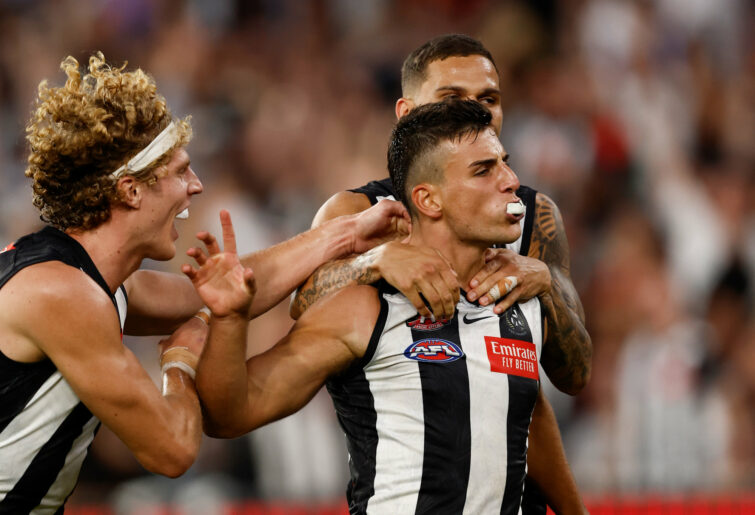St Kilda in peril yet again - but are their problems due to Lyon's coaching or the quality of the cattle?
For too long, St Kilda have alternated between minnow and mid-table - and it’s hard to see when it’s going to get better.
Opinion
The AFL draft, formerly seen as a measure of the league’s civility, once served the purpose of distributing the sport’s top juniors fairly, allocating more talent to those clubs which needed it the most.
This was previously thought to separate the AFL from sports such as soccer, in which capitalism is allowed to rule in unimpeded roughshod; but this is no longer the case, with our sport’s talent now picking and choosing their destination almost as freely as in the beautiful game.
Harley Reid, the 2023 number-1-pick-elect from Victoria’s Goulburn Valley, is said to have warned the West Coast Eagles from drafting him last week, in the ultimate power move, apparently also played by 2021 #1 pick Jason Horne-Francis.
Meanwhile Will Ashcroft, who was assumed as last year’s top draft talent, was allowed to nominate as a father-son selection, letting him navigate his way to the Brisbane Lions with pick #2, rather than being drafted by the GWS Giants with pick #1.

Will Ashcroft. (Photo by Albert Perez/AFL Photos via Getty Images)
This sort of occurrence happening once may be considered an accident, and twice a coincidence, but three times in a row now has the most desirable draft-eligible talent used either official or unofficial means to land at their club of choice.
As the top talent in each year’s draft continues to self-determine their own destinations, does it then make sense to do away the with Draft – as both a concession of a now ill-fitting system, and a recognition of the AFL as a truly national game.
The North Melbourne Kangaroos, the team which inauspiciously selected Horne-Francis first overall in 2021, did its best to force its will on its player, but was forced to cut its losses after a disastrous rookie year, trading him back home to South Australia.
While the saga did net North Melbourne picks #2 and #3 in the 2022 draft, it not only ensnared them in a PR nightmare – which future draftees will have noticed – but also cost them a season of nothing gained, setting back an already long and difficult rebuild another 12 months.
If in one solution, Horne-Francis became a free agent once he’d turned 18, he would’ve signed with a club in South Australia straight away – likely Port Adelaide, the team his stepfather Fabian Francis played at.
Even 12 months before Horne-Francis was drafted, Jamarra Ugle-Hagan made his way to the Western Bulldogs in another not altogether democratic manner.
Despite the fact the Bulldogs made the finals that season, the club was still able to jump above the Adelaide Crows, who held the #1 pick, to draft Ugle-Hagan, as he was a member of the club’s ‘Next Generation Academy’.
While the NGA does the lord’s work of encouraging participation from Aboriginal and non-traditional talent in the Australian game, it has also unleashed another convoluted draft “bidding” system on the AFL, allowing the clubs to perhaps fairly corner talent they have invested many man hours and millions in.
The NGA sits alongside several other wrinkles, such as the priority pick, zone allocations, and the father-son rule, which have rendered the draft as more of a formality than the exciting, equalisation mechanism it is in other sports around the world.
Perhaps when it was originally introduced, the AFL had hoped one day, the draft would also metastasise as another “football product” for the sport’s fans, expanding the League’s calendar, the way it does for the NFL, NBA, and NHL.
However it is unlikely the AFL’s draft will ever evolve into the showpiece event it is in North America, even despite the increased visibility of the sport’s top junior talent.
Attached to every player who gets picked in these overseas drafts comes a storyline crafted through their amateur career, playing under the NCAA, or in hockey’s case, at the annual World Junior Championships.
The AFL’s Under-19 Championships certainly has a far more amplified following among fans than it used to, particularly thanks the proliferation and dissemination of highlights across the internet and social media, however the inbuilt following of college athletics means the NFL and NBA drafts will likely always carry a greater significance.
Fearing the worst-case scenario of a world where talent is hoarded by the Victorian clubs in a VFL-style hellscape, it is unlikely the AFL will throw in the towel on the draft any time soon, however such a fear is not grounded in the reality of the sport.

Nick Daicos. (Photo by Michael Willson/AFL Photos via Getty Images)
Today’s AFL is a far more professional league than that which inaugurated the first modern draft in 1986.
No AFL player works a second job in 2023, like many players from the 1980s did, and ultimately, talent follows opportunity; no player will be content to play in the VFL each week when he believes he could fulfil his potential at another club, even one at the bottom of the standings.
This opportunity, alongside the salary cap and roster sizes, will continue to ensure every player who has the ability and the ambition has a home in the AFL.
The talent industry the AFL has developed over more than 150 years, including almost 40 of it in the draft era, ensures very few gifted players ever miss their opportunity; this would continue to be true, even if the League eliminated the draft.